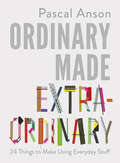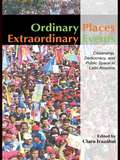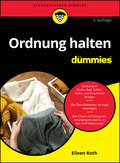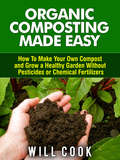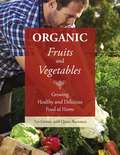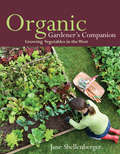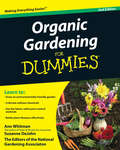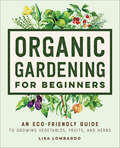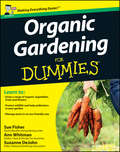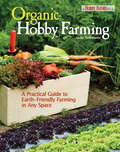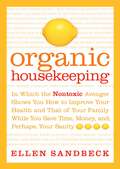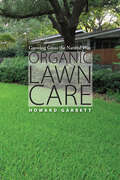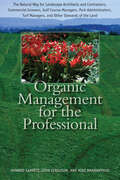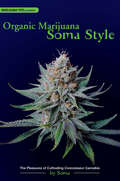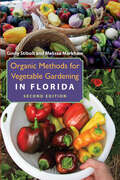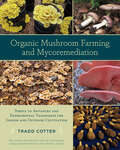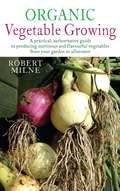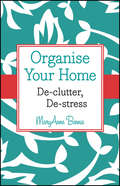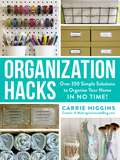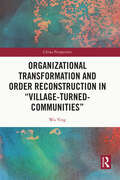- Table View
- List View
Ordinary Made Extraordinary
by Pascal Anson'Filled with inexpensive and relatively easy do-it-yourself design projects for the home. Step-by-step photos show you how to do everything from dipping vintage cutlery in paint and reupholstering an armchair in shoelaces to covering a wall in mirrors' - Telegraph 'True original Pascal Anson urges us, with winning wit and idiot-proof step-by-steps to turn ''dad'' jeans, an ugly table, holey trainers, mismatched cutlery [...] into desirable stuff using the alchemy of imagination. His brief? Low skill levels and high concept' - World of Interiors In Ordinary Made Extraordinary designer, artist and maverick-maker Pascal Anson shows how easy it is to transform everyday items into extraordinary statement pieces. Make ordinary a thing of the past with 24 inspiring and achievable projects including: - Create a chandelier with just a few rolls of Sellotape. - Cast a stunning concrete plant pot. - Build a child’s treehouse with cling film.There are ideas for projects for everyone – from repairing and reinventing worn out trainers, to bigger projects such as the wood-clad car and the stylish hairy chair.
Ordinary Places/Extraordinary Events: Citizenship, Democracy and Public Space in Latin America (Planning, History and Environment Series)
by Clara IrazábalClara Irazábal and her contributors explore the urban history of some of Latin America’s great cities through studies of their public spaces and what has taken place there. The avenues and plazas of Mexico City, Havana, Santo Domingo, Caracas, Bogotaì, SaÞo Paulo, Lima, Santiago, and Buenos Aires have been the backdrop for extraordinary, history-making events. While some argue that public spaces are a prerequisite for the expression, representation and reinforcement of democracy, they can equally be used in the pursuit of totalitarianism. Indeed, public spaces, in both the past and present, have been the site for the contestation by ordinary people of various stances on democracy and citizenship. By exploring the use and meaning of public spaces in Latin American cities, this book sheds light on contemporary definitions of citizenship and democracy in the Americas.
Ordnung halten für Dummies (Für Dummies)
by Eileen RothDamit Tohuwabohu ein Fremdwort bleibt Haben Sie es satt, ewig Ihren Schlüssel zu suchen und ihn später im Kühlschrank wiederzufinden? Ordnung halten: Dem einen ist es einfach gegeben, die anderen müssen es mühsam lernen. Eileen Roth zeigt Ihnen, wie Sie Ihr Zuhause ordentlich halten und Ihren Arbeitsplatz effizient gestalten. Außerdem erfahren Sie, wie Sie Ihre Daten auf Computer, Smartphone und Co. ordnen und Ihren Urlaub so planen, dass Sie richtig entspannen. Wenn Sie gut organisiert sind, haben Sie weniger Arbeit, weniger Stress, mehr Freizeit und mehr Entspannung. Mithilfe dieses Buches finden Sie immer, was Sie suchen Sie erfahren Welche Hilfsmittel Ihnen beim Ordnen helfen Was Sie aufheben sollten und was nicht Welche grundlegenden Techniken es für das Zeitmanagement gibt Wie Sie das Chaos mit System beseitigen
Organic Composting Made Easy: How to Make Your Own Compost and Grow a Healthy Garden Without Pesticides or Chemical Fertilizers
by Will CookEnrich your garden with this simple, practical guide to the composting process.Whether you have a tiny yard or a lot of space, you can grow delicious, healthy, organic vegetables and foods for you and your family—and composting is a key part of the process. A natural fertilizer and soil enhancer, compost can be bought in a store—but even better, you can create it yourself, making use of organic waste from your own home and kitchen instead of tossing it in the trash. This not only saves you money—it helps save the environment. With this informative book you’ll learn about:The benefits of composting for your garden and the earthHow the composting process worksTips and hints for easy compostingUnexpected approaches to organic composting, and more
Organic Fruits and Vegetables: Growing Healthy and Delicious Food at Home
by Teo Gomez Quico BarrancoThis book offers a clear picture of all that we need to know to make our small plot of land the most productive it can be. The authors present the information in a way that is cognizant to the people, plants, insects, and animals that live on the land. Thus, they do not recommend the use of pesticides or fertilizers or any other product that can be poisonous or unnatural. They choose organic seeds to maintain practices that promote, rather than destroy, the environment. This book contains, among other themes: * Horticultural techniques, from irrigation practices to sowing, tending, and harvesting * 1,001 ways to get rid of creatures that plague us, without exterminating them * All the plants we can grow and how to do so in the best way possible * Fruit trees, aromatic plants, and plants you can eat * Plants you should avoid * And much more!
Organic Gardener's Companion: Growing Vegetables in the West
by Jane ShellenbergerLifelong gardener Jane Shellenberger brings us this comprehensive, hands-on guide to growing organic produce in the Rocky Mountain and western region, including Colorado, parts of New Mexico, Arizona, Utah, Wyoming, Montana, Idaho, and eastern Oregon. The text covers soil cultivation, plant selection, water, microclimates, and other concerns specific to semiarid and high-altitude climates. Color photographs enhance this easy-to-use and accessible gardening guide.Jane Shellenberger is an eclectic gardener and environmental activist. She is publisher and editor of the regional gardening magazine Colorado Gardener, a thinking gardener's companion, which she founded in 1997. She is also a member of the Garden Writers Association. Shellenberger lives on a five-acre farmette on the plains between Boulder and Longmont, Colorado.
Organic Gardening For Dummies
by Suzanne Dejohn Ann Whitman The National Gardening AssociationOrganic Gardening For Dummies, 2nd Edition shows readers the way to ensure a healthy harvest from their environmentally friendly garden. It covers information on the newest and safest natural fertilizers and pest control methods, composting, cultivation without chemicals, and how to battle plant diseases. It also has information on updated equipment and resources. It helps readers plant organically year-round, using herbs, fruits, vegetables, lawn care, trees and shrubs, and flowers. The tips and techniques included in Organic Gardening For Dummies, 2nd Edition are intended to reduce a garden's impact on both the environment and the wallet.
Organic Gardening for Beginners: An Eco-Friendly Guide to Growing Vegetables, Fruits, and Herbs
by Lisa LombardoThe ultimate starter guide to a naturally healthy home gardenImagine cooking with organic tomatoes right off the vine or seasoning with fresh, homegrown herbs. Organic Gardening for Beginners shows aspiring home gardeners how to get started. Learn to raise dozens of fruits and veggies at home with sustainable and eco-friendly practices that protect the environment and produce safe, nutritious food—no grocery store required.Discover what it means to keep a completely organic garden with tips, advice, and step-by-step instructions for planting the right plants at the right time, designing an efficient layout, and attracting the right pollinators to help every garden thrive. Organic Gardening for Beginners is a perfect recommendation for a summer activity or summer hobby.Dig into organic gardening:Getting started—Begin with an overview of the most popular types of organic gardening—from in-ground to containers—and decide which one works best in every space.Natural growth methods—Find out how to choose soil, control pests with no chemicals, and combine the crops that grow well together.Plant profiles—Get an explanation of each crop that breaks down what it needs to grow and what beginners need to know for success.Grow your own thriving backyard ecosystem with expert advice on nourishing organic gardening.
Organic Gardening for Dummies, UK Edition
by Sue FisherReduce a garden's impact on both the environment and the walletOrganic Gardening For Dummies shows readers the way to ensure a healthy harvest from an environmentally friendly garden. It covers information on the newest and safest natural fertilizers and pest control methods, composting, cultivation without chemicals, and how to battle plant diseases. It also has information on updated equipment and resources. It helps the reader to plant organically year-round, using herbs, fruits, vegetables, lawn care, trees and shrubs, and flowers.Organic Gardening For Dummies show readers how to:Plan out the perfect organic gardenProtect wildlife and help pollinators in a gardenGrow a range of organic vegetables, fruits and flowersManage pests in an eco-friendly way
Organic Gardening without Poisons
by Hamilton TylerThis book explains how to restore health to the home garden by returning to natural gardening methods. Nature can benefit the gardener if he does not interfere with its complicated and delicate balance by using synthetic insecticides and fertilizers.
Organic Hobby Farming
by Andy TomolonisIn Organic Hobby Farming, Andy Tomolonis, a longtime organic gardener, part-time hobby farmer, and award-winning Boston-area journalist, strips down the concept of "organic" and explains why natural farming has emerged as the healthiest and most viable method of growing for hobby farms and other small-scale operations. In addition to the improved taste and the appeal of excluding toxic materials, organic farming benefits farmers, their families, and the environment. It offers economic plusses as well. The current consumer demand for "local" and "organic" food underscores the need for small hobby farms that offer unique high-end goods. Tomolonis explains the basic principles of organic farming and describes how hobby farmers and their families can eat healthier, save money, help preserve the environment, and even turn their passion into a small-scale side business.Chapter 1 will help you assess the land you live on to determine whether it's suited for organic vegetables, fruit, berries, or livestock. Farmers who are looking to lease or buy land will find practical advice on how to evaluate properties and find their best use, taking climate, soil, water and geography into consideration. In Chapter 2, Tomolonis continues with practical advice on how to choose the right tools without overspending-starting slowly with quality hand implements and then expanding as you determine the need for costlier power equipment.Chapter 3 moves on to the heart of any successful organic farm-building the soil. "The Good Earth" brings readers down to earth, i.e., the soil. You'll learn how to evaluate and improve your soil with compost and cover crops and protect it from erosion, chemical contamination and other harm. The author also stresses the importance of understanding the complex relationship between underground soil organisms that play such a crucial role in natural plant health. The best soil, with the right balance of nutrients and a healthy population of microbes, will help your plants survive hardship, resist diseases and produce healthier more bountiful harvests, the author explains.Chapter 4 walks you through the steps needed to develop an organized farm plan. The chapter presents a convenient month-by-month overview of the farmer's year, offering a timeline and detailed instructions for sowing seeds indoors, transplanting seedlings, guarding against insects and weeds, harvesting, planting cover crops extending the season and developing a schedule for successive food crops. Whether you want to feed your growing family all summer long or produce enough food for a small-scale agribusiness, the information here is invaluable. This chapter also covers organic methods for harnessing the power of nature by luring beneficial insects that will help control farm and garden pests.Learn about heirlooms, hybrids, and eclectic vegetable varieties in the comprehensive directory of vegetable crops and herbs introduced in Chapter 5. Tomolonis reveals his favorite varieties, including many alluring heirlooms that have grown in popularity. Each crop description offers detailed information on soil preparation, sowing, companion planting, and battling weeds and insects without harmful chemicals. The author, a former produce manager for a national grocery chain, also includes tips for harvesting crops, prepping them for display, and bringing the goods to market.If you're looking for advice on fruits and berries, Organic Hobby Farms introduces new options in Chapter 6, where the author suggests ways to branch out with Asian pears, peaches, and apples, as well as nutritious blueberries, blackberries, raspberries and strawberries. As he does in other chapters, Tomolonis explains in common terms, how to choose the best varieties for your region, prepare the soil for maximum production, and deal with pests and diseases organically.Organic Hobby Farming also describes the basics of adding chickens to your farm-for wholesome organic eggs or pastured meat. Select the right breeds, raise a flock from day-old chicks and protect the birds from predators and ...
Organic Housekeeping: In Which the Non-Toxic Avenger Shows You How to Improve Your Health and That of Your Family, While You Save Time, Money, and, Perhaps, Your Sanity
by Ellen SandbeckLonging for a kinder, gentler world? As the old saying goes, everything begins at home, and odds are, if you live in the all-American household, the air inside is more toxic than the air outside, even if you live in the most polluted of cities. You regularly handle the filthiest object in your home -- the kitchen sponge -- and put the same chemicals on your face that are used in brake fluid and antifreeze. The cleaning agents and personal care products commonly marketed to and used in American homes contain not only some very dangerous, toxic chemicals, but they also create an "overly clean," chemically bombed-out house that compromises immune systems. And with more than fifty million Americans suffering from allergies and other autoimmune diseases -- not to mention the developing and fragile immune systems of children and seniors -- large numbers of people are actually being made sicker and sicker by their homes. Learn to live a clean, healthy, more economical way with Ellen Sandbeck, the nontoxic avenger. In this must-have book for the twenty-first- century home, this passionate, witty advocate of all things organic will teach you how to maintain every part of the home -- from living room to septic tank, kitchen floor to bathroom sink -- using safe, simple cleansers and quick preventative measures as well as the most effective organic products on the market to get the job done. Learn time-saving, preventative housekeeping, such as taking thirty seconds to clean the shower while you shower. Take care of bathroom stains with baking soda and vinegar rather than commercial, toxic bathroom "bombs" peddled to you with such force by manufacturers. Need whiter whites? There is no bleaching power on earth stronger than the sun. Snow clean your fine rugs. Choose fruits and vegetables from the relatively pesticide residue-free list. Clean felt-tipped pen stains with vodka. Make furniture shine with olive oil and lemon. Your house will also smell as great as it looks.
Organic Lawn Care: Growing Grass the Natural Way
by Howard GarrettA renowned landscape gardener&’s guide to less expensive, less water-intensive lawns, whether it&’s a front yard or a fairway.A lush green lawn is one of the great pleasures of the natural world, whether it&’s outside your front door or on a majestic fairway at a legendary golf course. But anyone who&’s tried to grow the perfect lawn the conventional way knows it requires an endless cycle of watering and applying synthetic fertilizers and toxic chemical pesticides that costs a lot of money and kills all the life in the soil, on the surface, and on the grass. Fortunately, there&’s a better way. Organic lawn care is not only healthier for the environment, it&’s actually cheaper and less water-intensive, whether you&’re managing a small yard or acres of turf. In this book, Howard Garrett, the renowned &“Dirt Doctor,&” takes you step-by-step through creating and maintaining turf organically. He begins with the soil, showing you how to establish a healthy habitat for grass. Then he discusses a variety of turfgrasses, including Bermudagrass, bluegrass, buffalo grass, fescue, ryegrass, St. Augustine, and zoysia. He explains in detail planting, mowing, watering, fertilizing, composting, and managing weeds and pests. And he offers alternatives to lawn grasses and turf, describing the situations in which they might be your best choice.
Organic Lawn Care: Growing Grass the Natural Way
by Howard GarrettA renowned landscape gardener&’s guide to less expensive, less water-intensive lawns, whether it&’s a front yard or a fairway.A lush green lawn is one of the great pleasures of the natural world, whether it&’s outside your front door or on a majestic fairway at a legendary golf course. But anyone who&’s tried to grow the perfect lawn the conventional way knows it requires an endless cycle of watering and applying synthetic fertilizers and toxic chemical pesticides that costs a lot of money and kills all the life in the soil, on the surface, and on the grass. Fortunately, there&’s a better way. Organic lawn care is not only healthier for the environment, it&’s actually cheaper and less water-intensive, whether you&’re managing a small yard or acres of turf. In this book, Howard Garrett, the renowned &“Dirt Doctor,&” takes you step-by-step through creating and maintaining turf organically. He begins with the soil, showing you how to establish a healthy habitat for grass. Then he discusses a variety of turfgrasses, including Bermudagrass, bluegrass, buffalo grass, fescue, ryegrass, St. Augustine, and zoysia. He explains in detail planting, mowing, watering, fertilizing, composting, and managing weeds and pests. And he offers alternatives to lawn grasses and turf, describing the situations in which they might be your best choice.
Organic Management for the Professional: The Natural Way for Landscape Architects and Contractors, Commercial Growers, Golf Course Managers, Park Administrators, Turf Managers, and Other Stewards of the Land
by Howard Garrett Mike Amaranthus John FergusonA handbook for organic landscaping and turf management for recreational and commercial properties, public spaces, parks and urban gardens. Can you manage the landscape of a golf course, city park, or corporate campus without synthetic fertilizers and toxic pesticides? Absolutely! Organic landscaping is not only possible on a large scale, but it also makes sense both economically and environmentally. It promotes healthy soils and plants, which require less water and sequester more carbon—a winning combination for both your bottom line and the planet&’s fight against resource depletion and global warming. Organic programs on a commercial scale have enormous potential to make a difference in the quality of our environment, our use of fuels, and climate change. And as those who have already converted to organics have discovered, they also cost a lot less over the long term. Organic Management for the Professional is the first comprehensive guide to &“going green&” in large-scale landscaping. Nationally recognized organic gardening expert Howard Garrett, with associates John Ferguson and Mike Amaranthus, not only explains in detail how to manage projects with natural organic techniques, but also presents the material in clear, simple terms so that commercial and institutional property owners can understand what to ask of their landscape architects, contractors, growers, and maintenance people. They give detailed, proven instructions for the key components of organic landscaping—soil building, correct planting techniques, fertilizing, pest control, compost, and mulch. Then they show how to apply these organic methods in large-scale landscaping, commercial growing, such as orchards, tree farms, nurseries, and greenhouse operations, and recreational properties such as sports fields and parks.
Organic Marijuana, Soma Style
by SomaA breeder of international fame, Soma is synonymous with earth-friendly grow techniques and an appreciation for the healing qualities of marijuana. Now in his first-ever book, this sage of the marijuana scene shares his methods and philosophy with a collection of his best works, all-new essays and stunning photography.Soma offers detailed advice for every stage of growing organically: selecting seeds and mother plants, making clones, creating one's own soil mix, using organic pest control and knowing the best time for harvesting. With these instructions, gardeners of all levels can learn to grow marijuana with the sublime qualities and subtleties of flavor and effects that have made this breeder legendary. Sixteen pages of Soma's lush full-color photography help to showcase his methods and varieties.Much like organic food has become increasingly popular through a heightening of awareness, Organic Marijuana raises consciousness about growing an outstanding crop of marijuana while respecting both environmental and individual health.This second book in the Marijuana Tips series continues to present the tips and techniques that only expert growers can provide.
Organic Marijuana, Soma Style
by SomaA breeder of international fame, Soma is synonymous with earth-friendly grow techniques and an appreciation for the healing qualities of marijuana. Now in his first-ever book, this sage of the marijuana scene shares his methods and philosophy with a collection of his best works, all-new essays and stunning photography.Soma offers detailed advice for every stage of growing organically: selecting seeds and mother plants, making clones, creating one's own soil mix, using organic pest control and knowing the best time for harvesting. With these instructions, gardeners of all levels can learn to grow marijuana with the sublime qualities and subtleties of flavor and effects that have made this breeder legendary. Sixteen pages of Soma's lush full-color photography help to showcase his methods and varieties.Much like organic food has become increasingly popular through a heightening of awareness, Organic Marijuana raises consciousness about growing an outstanding crop of marijuana while respecting both environmental and individual health.This second book in the Marijuana Tips series continues to present the tips and techniques that only expert growers can provide.
Organic Marijuana, Soma Style: The Pleasures of Cultivating Connoisseur Cannabis
by SomaA breeder of international fame, Soma is synonymous with earth-friendly grow techniques and an appreciation for the healing qualities of marijuana. Now in his first-ever book, this sage of the marijuana scene shares his methods and philosophy with a collection of his best works, all-new essays and stunning photography.Soma offers detailed advice for every stage of growing organically: selecting seeds and mother plants, making clones, creating one's own soil mix, using organic pest control and knowing the best time for harvesting. With these instructions, gardeners of all levels can learn to grow marijuana with the sublime qualities and subtleties of flavor and effects that have made this breeder legendary. Sixteen pages of Soma's lush full-color photography help to showcase his methods and varieties.Much like organic food has become increasingly popular through a heightening of awareness, Organic Marijuana raises consciousness about growing an outstanding crop of marijuana while respecting both environmental and individual health.This second book in the Marijuana Tips series continues to present the tips and techniques that only expert growers can provide.
Organic Methods for Vegetable Gardening in Florida
by Ginny Stibolt Melissa MarkhamHow to grow delicious produce in your own backyard In this guide, expert botanist Ginny Stibolt and Master Gardener Melissa Markham provide simple and accessible advice for successful vegetable gardening in Florida, where soil types vary and cool-weather crops are grown right through the mild winters. They offer advice on what to do with over-abundant harvests, strategies for developing a community garden, and suggestions for opportunities beyond the home garden. They also address integrated pest management, appropriate raised bed types, irrigation, seed saving, just-in-time harvesting, and food safety.This second edition is updated with the latest scientific knowledge and growing techniques; new crops for growers to try; more detail in the growing calendars separated by north, central, and south Florida regions; and color photos and illustrations throughout the text. Readers will appreciate this reliable resource that will help them and their families become more resilient by controlling some of their food from seed to table.
Organic Mushroom Farming and Mycoremediation: Simple to Advanced and Experimental Techniques for Indoor and Outdoor Cultivation
by Tradd CotterAn in-depth exploration of organic mushroom cultivation practices, groundbreaking research and myriad ways to incorporate mushrooms into your life&“A clear, comprehensive guide that is a gift to amateur as well as professional mushroom growers. This book opens the doors wide to a diverse and fascinating fungal world.&”—Toby Hemenway, author of Gaia&’s GardenWhat would it take to grow mushrooms in space? How can mushroom cultivation help us manage, or at least make use of, invasive species such as kudzu and water hyacinth and thereby reduce dependence on herbicides? Is it possible to develop a low-cost and easy-to-implement mushroom-growing kit that would provide high-quality edible protein and bioremediation in the wake of a natural disaster? How can we advance our understanding of morel cultivation so that growers stand a better chance of success? For more than twenty years, mycology expert Tradd Cotter has been pondering these questions and conducting trials in search of the answers. In Organic Mushroom Farming and Mycoremediation, Cotter not only offers readers an in-depth exploration of best organic mushroom cultivation practices; he shares the results of his groundbreaking research and offers myriad ways to apply your cultivation skills and further incorporate mushrooms into your life―whether your goal is to help your community clean up industrial pollution or simply to settle down at the end of the day with a cold Reishi-infused homebrew ale. Inside, you&’ll find:The Fundamentals of Mushroom CultivationInnovative Applications and Projects Using FungiBasic Laboratory Construction, Equipment, and ProceduresStarting Cultures and Spawn GenerationDetailed descriptions of over 25 different genusThe book first guides readers through an in-depth exploration of indoor and outdoor cultivation. Covered skills range from integrating wood-chip beds spawned with king stropharia into your garden and building a &“trenched raft&” of hardwood logs plugged with shiitake spawn to producing oysters indoors on spent coffee grounds in a 4×4 space or on pasteurized sawdust in vertical plastic columns. For those who aspire to the self-sufficiency gained by generating and expanding spawn rather than purchasing it, Cotter offers in-depth coverage of lab techniques, including low-cost alternatives that make use of existing infrastructure and materials. Cotter also reports his groundbreaking research cultivating morels both indoors and out, &“training&” mycelium to respond to specific contaminants, and perpetuating spawn on cardboard without the use of electricity. Readers will discover information on making tinctures, powders, and mushroom-infused honey; making an antibacterial mushroom cutting board; and growing mushrooms on your old denim jeans.Geared toward readers who want to grow mushrooms without the use of pesticides, Cotter takes &“organic&” one step further by introducing an entirely new way of thinking―one that looks at the potential to grow mushrooms on just about anything, just about anywhere, and by anyone.&“This comprehensive introduction to growing and utilizing fungi has something for all mushroom-inclined readers . . . . Both practical and passionate, Cotter offers extensive and detailed information.&”—Publishers Weekly
Organic Vegetable Growing: A Practical, Authoritative Guide To Producing Nutritious And Flavourful Vegetables From Your Garden Or Allotment
by Robert MilneGrowing your own organic vegetables will give you fresher, tastier and more nutritious produce with no food miles, fossil fuel use or packaging; and will provide you with the simple but enormous pleasure and satisfaction of supplying at least part of your own food requirements. This authoritative book provides detailed, practical guidance for those who wish to make the most of their time and whatever area of ground is available to grow vegetables the organic way. It looks forward to productive gardening becoming increasingly relevant and necessary as we are obliged to adapt to global trends, including climate change and diminishing oil resources that will adversely affect food production. The techniques described are applicable to any scale of gardening and are based on the author's thirty years of organic gardening experience, including twenty years of self-sufficiency and eight as a professional gardener growing vegetables and fruit in walled gardens.
Organise Your Home: De-clutter, De-stress
by MaryAnne BennieIs your clutter taking control of your life? Organise Your Home will show you how to use the in8steps system and organise your entire home without turning it into total chaos in the process. Work at a pace your lifestyle allows and use this tried-and-tested system to completely overhaul your relationship with your stuff. MaryAnne Bennie is an organising expert, speaker and director of in8 home office and life organising.
Organization Hacks: Over 350 Simple Solutions to Organize Your Home in No Time! (Life Hacks Series)
by Carrie HigginsFix your cluttered cabinets, overflowing drawers, and messy living areas with these tips, tricks, and project ideas from Carrie Higgins, the organization expert of the Making Lemonade blog.Carrie Higgins has made it her mission to share fresh ideas for the home on her blog Making Lemonade. In this guide she has collected her best quick fixes, innovative hacks, and DIY solutions to keep your home looking beautiful, such as: -Using a ladder and a collection of S-hooks for additional pots and pans storage -Attaching a binder clip to your nightstand for your phone charger so the end never falls under the bed again -Using daylight saving time as a reminder to check the expiration date on the medications in your cabinet. And some of her more in-depth projects include: -DIY magnetic spice jars to keep spices on your fridge and near at hand -Easy-attach baskets for storing bath toys for the little ones -A foolproof travel packing grid for quick and easy getaways With Organization Hacks, you can get your house in order and turn your home from a hoarding nightmare into a clutter-free paradise!
Organizational Transformation and Order Reconstruction in "Village-Turned-Communities" (China Perspectives)
by WU YingSince the beginning of the 21st century, a state-led urbanization has evolved into a "city management" in China: a large number of villages were demolished; cultivated land was centralized; and peasants went to live in apartments, which led to the widespread emergence of "village-turned-communities". This title explores the evolving and complex relationship between the urbanization of land and people – two core components of China’s urbanization strategy. What role does the government play in creating conflicts around these two aspects of urbanization? What role can it play in adjudicating them? To answer these questions, the author examines rural migrants’ experience in integrating and being integrated into the cities. Through a three-year investigation in Beijing, Shandong, Wuhan and Yunnan, the author shows how government policies can either engender or mitigate conflicts, as well as identifies integrated governance as an effective approach to urbanization of both land and people. This title is awarded the top ten Chinese sociology books in 2019. Students and scholars of sociology, politics and public administration will benefit from this book.
